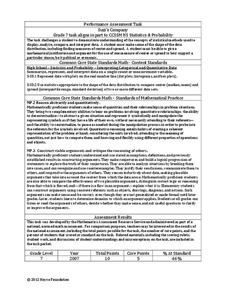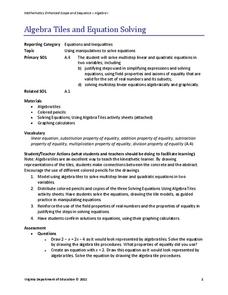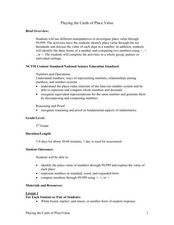Curated OER
Counting and Math Concepts
Students practice counting to the number three. In this number sense instructional activity, students practice counting to the number three by using various objects. Students arrange and count the objects.
Curated OER
Symmetry with Manipulatives
First graders investigate symmetry in patterns by utilizing unifix cubes. In this pattern lesson, 1st graders practice creating patterns that are perfectly symmetrical no matter which way it's looked at. Students utilize...
Curated OER
Jack Math Scramble
Students practice throwing and catching jacks to improve their hand-eye coordination. In groups, they participate in a variety of games in which they use the jacks to improve their problem solving skills. To end the lesson, they pick up...
Curated OER
Muppet Math Patterning
Young scholars participate in determining the completion of patterns and discovering which part of the pattern doesn?????™t belong.
Texas Instruments
Graphing Calculator Investigation Graphs of Relations
Learners investigate relations in this algebra lesson. They graph the set of ordered pairs that determine a relation. Using a TI-83 Plus, your learners will enter the coordinates in a list, create a scatter plot, and manipulate the...
Curated OER
Fractions and Decimals
Third graders use fractions manipulatives to explore fractions. In this fraction lesson, 3rd graders work in groups based on skill to increase understanding of fractions. Students create fraction books.
Curated OER
Can You Name That Shape?
Learners use materials to build, investigate, and draw two-dimensional shapes (polygons). They combine the shapes they have built and draw from the pile to begin a round-robin activity to name and determine the attributes of a selection...
Curated OER
It's a 3-D World Out There!
Students construct polygons. They identify attributes of three-dimensional shapes. Students name common three-dimensional shapes. They draw three-dimensional shapes, and sort three-dimensional shapes. Students use K'NEX materials sets to...
Inside Mathematics
Party
Thirty at the party won't cost any more than twenty-five. The assessment task provides a scenario for the cost of a party where the initial fee covers a given number of guests. The class determines the cost for specific numbers of guests...
Inside Mathematics
Suzi's Company
The mean might not always be the best representation of the average. The assessment task has individuals determine the measures of center for the salaries of a company. They determine which of the three would be the best representation...
Inside Mathematics
Marble Game
Pupils determine the theoretical probability of winning a game of marbles. Individuals compare the theoretical probability to experimental probability for the same game. They continue on to compare two different probability games.
Curated OER
Equal Shmequal by Virginia Kroll
Students read a book and complete exercises to explore the meaning of 'equals.' In this equal numbers lesson, students brainstorm the meaning of equals and read a story about the topic. Students use manipulatives to study balance and...
Virginia Department of Education
Algebra Tiles and Solving Equations
Young mathematicians solve linear equations by drawing models of algebra tiles using colored pencils. To finish, they solve the same equations algebraically and check their answers using a graphing calculator.
Curated OER
Orthographic Drawings
Students investigate the creation of three dimensional drawings. In this geometry lesson, students analyze and complete orthographic drawings. They Cabri software to manipulate and move the drawings around.
Curated OER
Fractions in Shapes
First graders explore fractions with manipulatives. In this fraction activity, 1st graders use paper foods such as sandwiches and pizza in order to find halves, thirds, fourths, eighths, and more. This activity is divided up into 3 tiers...
Curated OER
Numerical Analysis: Successive Intervals
In this successive interval worksheet, students find the approximation of a root, using the Bisection Algorithm. They identify intervals, and use algebraic manipulation to identify functions that have a fixed point.
Curated OER
Operations of Polynomials
Students investigate the concept of manipulating polynomials. They go through the process of using algebra tiles in order to practice grouping of like terms and model the solving process.
Curated OER
Leaf Patterns
First graders explore the existence of patterns in everyday items. In this science and math integrated lesson, 1st graders match leaves with a name word card and organize them into four patterns. This lesson includes a reading of And the...
National Nanotechnology Infrastructure Network
Is Measuring an Art or a Science?
Not only do future engineers learn the difference between accuracy and precision, they also get some hands-on experience using different measuring tools.
Curated OER
How the West Was One - Three x Four
While this lesson provides a motivating and interesting way to review the concept of the order of operations, it involves the use of software called How the West Was One + Three x Four. There are also other resources that are referenced,...
Curated OER
Place Value of Whole Numbers Through One Million
Third graders construct numbers to the millions place. In this 30-page place value lesson, learners create numbers and evaluate the place value of digits. They explore standard and expanded form of numbers. An incredible resource!
Curated OER
Exploring Equivalent Fractions
An extensive lesson explores equivalent fractions and is intended for three 60-minute periods. Young mathematicians compare and order fractions with like and unlike denominators. Included are worksheets, assessments, and answer sheets;...
Curated OER
How Big Is That Star?
Aspiring astronomers study stars. They compare stars and explain the relationship between radius, mass, and diameter. By creating a star simulation, they discover how a binary star system's orbit can cause changes in the observed...
Curated OER
Playing the Cards of Place Value
Third graders explore place value to the ten-thousands place. For this amazing, 21-page place value lesson, learners represent numbers in standard and expanded form, and use technology to represent numbers to 9,999.























